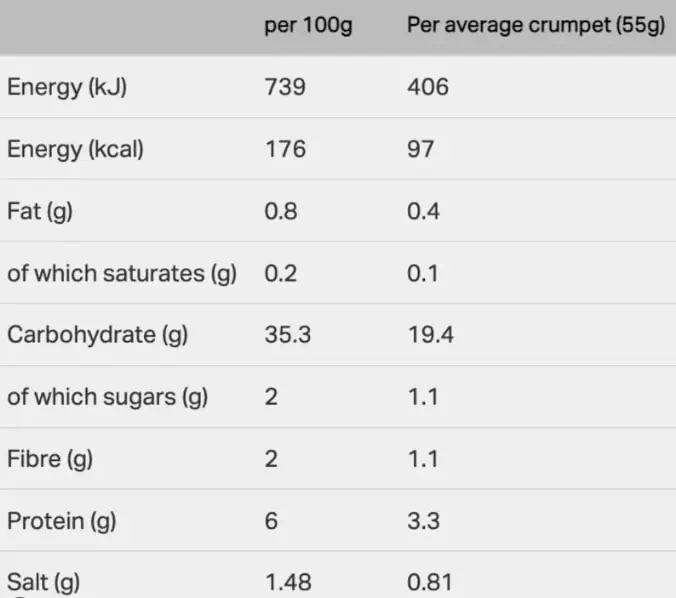Crumpets are a delicious and versatile food. They can be enjoyed for breakfast, lunch, or dinner. But are crumpets healthy? Let’s take a closer look.
The answer to this question depends on a few factors. First, let’s look at the nutritional content of crumpets. A typical crumpet contains about:
- 200 calories
- 4 grams of protein
- 2 grams of fiber
- 10 grams of sugar
- 10 grams of fat
From a nutritional standpoint, crumpets are not exactly a health food. However, they are not an unhealthy food either. They fall somewhere in the middle. If you are looking for a healthy breakfast option, there are certainly better choices out there. However, if you are looking for something to indulge in occasionally, crumpets are a perfectly reasonable option.

Another factor to consider is how you toppings you choose. Crumpets are often served with butter, honey, or Jam. These toppings can add significant amounts of calories, sugar, and fat to your meal. If you are looking to keep your crumpets healthy, choose toppings like almond butter or avocado instead. These toppings will add some healthy fats and nutrients to your meal without going overboard on the sugar and calories.
Ah, crumpets, those delightful British griddle cakes that have warmed the hearts and filled the bellies of countless breakfast-goers for generations. But have you ever wondered, “are crumpets healthy?” With the rise of health-conscious diets and an increased focus on nutrition, it’s natural to question how this beloved staple fits into a balanced diet. Fear not, dear reader, for we are about to embark on a delicious journey to uncover the truth about crumpets and their nutritional value.
In this in-depth exploration, we’ll compare crumpets to their close cousin, bread, and dive into their nutritional profiles. We’ll discuss the health benefits of crumpets, including bone health, complex carbohydrates, and essential nutrients, and how to make healthier choices with toppings. We’ll also touch on the topic of gluten-free crumpets and their role in a healthy lifestyle, as well as the importance of salt reduction and mindful eating. I know, I know the question is are crumpets healthy or not? So, grab your favourite cup of tea and let’s set sail on this crumpet adventure!

Key Takeaways
- Crumpets and bread have different nutritional profiles, with crumpets being lower in calories but also having less fibre and fewer nutrients.
- Crumpets provide beneficial nutrients for bone health, energy, and essential vitamins & minerals when enjoyed in moderation as part of a balanced diet.
- Mindful eating with crumpets can help slow down digestion while still enjoying the taste benefits through healthy toppings like avocado or hummus.

Crumpets vs. Bread: A Nutritional Comparison
Crumpets and bread, two breakfast staples that have graced our plates for centuries. But how do these two compare when it comes to nutrition? Are crumpets healthy? or should we be reaching for a slice of bread instead? While both can have a place in a balanced diet, there are some differences in their nutritional profiles.
Crumpets are made from a combination of flour, yeast, and water, resulting in a unique texture that sets them apart from their crumpets bread counterparts. This simple recipe results in lower calories than most bread slices, making crumpets healthier in terms of calorie content. However, they also have less fibre and fewer nutrients. On the other hand, bread, especially wholemeal varieties, is higher in calories but also richer in nutrients and fiber, making it a healthier option overall. The choice between crumpets and bread ultimately boils down to individual preferences and dietary needs.

Crumpets: Nutritional Facts
At first glance, crumpets seem like a simple, innocent breakfast food. Made from refined flour, water, salt, and yeast, they are low in calories, with a typical crumpet containing 82 calories. Keep in mind, crumpets may not supply all the necessary nutrients and fiber our diets require.
The nutritional value comparison between white and wholegrain crumpets is quite intriguing. White crumpets tend to be lower in carbohydrates and higher in dietary fibre, while wholegrain crumpets boast a higher fibre content and more nutritional value. This means that if you’re looking to maximize the health benefits of your crumpet indulgence, opting for wholegrain crumpets might be the way to go.
Unfortunately, there is no available information regarding the glycaemic index of crumpets. However, it’s safe to say that, as with any food, moderation is key. Enjoying crumpets as part of a balanced diet and being mindful of portion sizes can help ensure that you’re getting the most out of this tasty treat without compromising your health goals.

Homemade crumpets
Making crumpets is quite a delightful process that requires few ingredients but delivers a lot of satisfaction. To start, you’ll need 2 cups of all-purpose flour, 1 teaspoon of sugar, 1/2 teaspoon of salt, 1 cup of warm milk, 1 tablespoon of active dry yeast, and 1/2 cup of warm water.

quick homemade crumpets ingredients
- 2 cups of all-purpose flour
- 1 teaspoon of sugar
- 1/2 teaspoon of salt
- 1 cup of warm milk
- 1 tablespoon of active dry yeast
- 1/2 cup of warm water
Here’s a simple guide: First, combine the flour, sugar, and salt in a large bowl. In a separate bowl, dissolve the yeast in warm water, then add it to the dry ingredients along with the warm milk. Mix until you have a smooth batter. Cover the bowl with a clean cloth and let it sit in a warm place for about an hour, or until the mixture is bubbly. Heat a lightly greased frying pan over medium heat. Pour batter into crumpet rings (if you have them) or directly onto the pan to form small circles. Cook for about 3-4 minutes on one side, until bubbles form on the surface, then flip and cook for another 2 minutes. Serve warm with your favourite toppings. Enjoy your homemade crumpets!
Calories in homemade crumpets
To estimate the calorie content of homemade crumpets based on the given recipe, we calculate the total calories from all ingredients and divide by the number of crumpets produced. Assuming 10 crumpets are made, the ingredients sum up to approximately 2001 calories, resulting in about 200 calories per crumpet. This is a rough estimate, as actual calories can vary with ingredient choices and serving sizes.

Bread: Nutritional Facts
Focusing on bread now, specifically whole wheat bread, reveals more. A slice of whole wheat bread contains approximately:
- 82 calories
- 9.6 net carbohydrates
- 4 grams of protein
- 2-3 grams of fibre
This makes bread a more nutrient-dense option compared to crumpets, especially when it comes to fiber and protein content.
Wholemeal flour in wholegrain crumpets contributes additional dietary fibre, helping to slow digestion and consequently decrease the number of calories entering the bloodstream. This makes wholemeal bread a healthier option overall, providing more nutrients and fibre to support a balanced diet.

The Health Benefits of Crumpets
While we’ve established that crumpets may not boast the same nutrient density as whole wheat bread, they do offer some health benefits worth considering. From promoting bone health to providing complex carbohydrates for energy, crumpets have more to offer than just a delicious taste.
We’ll next explore the specific health benefits of crumpets, which include their role in promoting bone health, the merits of their complex carbohydrate content, and the essential nutrients they offer.
Bone Health
One of the health benefits of crumpets lies in their contribution to bone health. Crumpets contain calcium and phosphorus, both of which are essential for maintaining bone health. A single crumpet provides roughly 100mg of calcium, which is a significant amount considering the daily recommended intake of calcium for adults ranges between 1,000 and 1,300mg.
Although crumpets do not contain phosphorus, they can still be part of a balanced diet that includes other sources of calcium and phosphorus, such as:
- Dairy products
- Seafood
- Organ meats
- Nuts
- Seeds
- Poultry
Including crumpets as a source of calcium in your diet can help support bone health and reduce the risk of conditions such as osteoporosis, especially in menopausal women who are more prone to bone loss.

Complex Carbohydrates
Another advantage of crumpets is their complex carbohydrate content. Crumpets are predominantly composed of whole grains, providing a substantial amount of fibre and complex carbohydrates. These complex carbohydrates play a crucial role in providing a steady source of energy throughout the day.
Complex carbohydrates in crumpets provide energy by being broken down into glucose, which the body uses as a source of fuel. These complex carbohydrates, found in foods such as whole-grains, provide a sustained release of energy over a longer period of time compared to simple carbohydrates.
So, if you’re looking for a breakfast option that provides lasting energy, crumpets might just be the perfect choice.
Essential Nutrients
Crumpets also contain essential nutrients such as:
- B vitamins, which offer numerous health benefits, including supporting a healthy metabolism, maintaining optimal brain function, assisting in energy production, bolstering the immune system, and promoting healthy skin, hair, and nails
- Iron, which plays an important role in promoting overall health by aiding in the production of red blood cells and the transportation of oxygen throughout the body
- Magnesium, which is essential for maintaining normal muscle and nerve function, regulating blood sugar levels, and promoting healthy bone structure
These nutrients make crumpets a nutritious and delicious choice for breakfast or a snack.
By enjoying crumpets as part of a British diet, you can reap the benefits of these essential nutrients and contribute to your overall well-being, while still maintaining a balanced diet and incorporating health food.
Crumpet Toppings: Making Healthy Choices

Savoring a delectable crumpet calls for careful selection of toppings. While it’s tempting to slather on generous amounts of butter and jam, opting for healthier alternatives can boost the nutritional value of your crumpet and support a balanced diet. Some healthier toppings to consider include:
- Avocado slices
- Hummus
- Greek yogurt
- Fresh fruit
- Nut butter
- Cottage cheese
These options provide a delicious and nutritious twist to your traditional crumpets experience.
Consider toppings such as almond butter, avocado, or fresh fruit for a more nutritious option. These healthy choices not only enhance the flavour of your crumpet but also provide additional vitamins, minerals, and healthy fats that contribute to a well-rounded diet.
Gluten-Free Crumpets: A Healthier Alternative?
Gluten-free crumpets might appeal to those with gluten sensitivities or celiac disease. Some reasons why gluten-free crumpets may be a healthier alternative for those who are unable to consume gluten are:
- They generally have lower fat content compared to regular crumpets
- They can be made with healthier ingredients, such as whole grains or alternative flours
- They may be fortified with additional nutrients to make up for the lack of gluten
Gluten-free crumpets typically include:
- Gluten-free flour (such as rice flour or gluten-free self-raising flour)
- Yeast
- Milk (dairy-free or vegan options can be used)
- Sugar
- Salt
Some recipes may also include additional ingredients like xanthan gum, egg powder, or baking powder in their crumpet batter. By opting for gluten-free crumpets, individuals with gluten sensitivities or celiac disease can still enjoy this classic British treat without compromising their health.

Salt Reduction Targets and Crumpets
A heightened awareness of potentially high salt levels in crumpets, particularly the store-bought varieties, is beneficial for maintaining healthy blood pressure. Excessive consumption of salt can be detrimental to our health. Some brands may contain a significant amount of salt up to 15% of your daily recommended intake in a single crumpet. Considering that adults are recommended to consume no more than 2,300 milligrams (mg) of salt per day, with an ideal limit of no more than 1,500 mg per day, it’s crucial to be mindful of salt reduction targets when consuming crumpets regularly.
Opting for low-salt crumpet alternatives, such as Sainsbury’s Taste the Difference Luxury Multiseed Sourdough Crumpets, can be a healthier option for those looking to reduce their salt intake. By being mindful of salt reduction targets and making informed choices, you can continue to enjoy crumpets as part of a balanced diet.
Crumpets and Weight Management

Moderate consumption of crumpets along with healthy toppings can fit well into a weight management plan. A typical crumpet contains 82 calories, which is comparatively lower than other breakfast foods. Additionally, the fiber content in crumpets can help you feel fuller for longer, aiding digestion, and regulating blood sugar levels.
A moderate portion size of crumpets for a healthy weight management plan is generally one crumpet, weighing approximately 50 grams. By being mindful of portion sizes and choosing nutritious toppings, you can include crumpets in your weight management journey without sacrificing taste or causing unwanted weight gain.
Mindful Eating with Crumpets
Adopting a mindful approach to eating crumpets can contribute to a balanced diet and curb overeating. Mindful eating is a practice that involves utilizing all of your physical and emotional senses to savor and appreciate the food you eat. By focusing on your food and eating at a slower pace, mindful eating can improve digestion, foster control over eating habits, and enable more thoughtful food choices.

To practice mindful eating with crumpets, follow these steps:
- Take a moment to check in with yourself before eating. Notice any physical sensations or emotions you may be experiencing.
- Engage all your senses while enjoying your crumpet. Notice the smell, texture, and taste of the crumpet. Take small bites and savor each one.
- Pay attention to your body’s hunger and fullness cues. Eat slowly and stop when you feel satisfied, rather than overly full. By being present and mindful during your crumpet experience, you can maintain a balanced diet and truly savor this delightful British treat.
Summary
In conclusion, crumpets can be a healthy addition to your diet if consumed in moderation and paired with nutritious toppings. While they may not provide the same fiber and nutrient density as wholemeal bread, crumpets do offer some health benefits such as bone health, complex carbohydrates, and essential nutrients.
By practicing mindful eating and making informed choices, you can enjoy the classic taste of crumpets while maintaining a balanced diet and supporting your health goals. So, go ahead and treat yourself to a warm, delicious crumpet, knowing that you’re making a mindful choice for your body and soul.
Frequently Asked Questions
Are crumpets full of sugar?
Crumpets generally contain very low amounts of sugar compared to cakes and pastries, and should be enjoyed as an occasional treat. Try not to add butter or sweet spreads for a healthier snack.
How many crumpets should I eat?
It’s recommended to limit yourself to two crumpets when applying a spread, as any more than three will lead to diminishing returns and no comfort gained.
Do crumpets have a lot of calories?
A single crumpet contains 86 calories, with 100g containing 176 calories, so they are relatively low in calories.
Are crumpets a healthier option than bread?
Crumpets are lower in calories than most bread slices, making them a slightly healthier option; however, they contain less fiber and fewer nutrients, so the choice between crumpets and bread ultimately comes down to individual preferences and dietary needs.
What are some healthy toppings for crumpets?
Almond butter, avocado, and fresh fruit make delicious and healthy toppings for crumpets.
The Health Benefits of Crumpets
So why are crumpets so good for menopausal women? First of all, they’re a great source of fiber. Fiber is essential for proper digestion, which can be particularly important for menopausal women who often experience digestive issues. Additionally, fiber can help to keep you feeling full and satisfied after eating, which can help to prevent overeating and weight gain.
Crumpets are also rich in vitamins and minerals like iron, calcium, and magnesium. These nutrients are important for maintaining bone health, which is especially important for menopausal women who are at risk for osteoporosis. And last but not least, crumpets are a good source of whole grains. Whole grains have been shown to reduce the risk of heart disease, stroke, and diabetes—all conditions that become more common after menopause.
To sum it up, crumpets are not exactly a health food but they are also not an unhealthy food. They fall somewhere in the middle. If you are looking for a healthy breakfast option, there are certainly better choices out there but if you are looking for something to indulge in occasionally, crumpets are a perfectly reasonable option. Just be mindful of your toppings!












